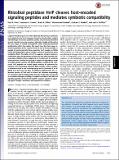Rhizobial peptidase HrrP cleaves host-encoded signaling peptides and mediates symbiotic compatibility
Author(s)
Price, Paul A.; Tanner, Houston R.; Dillon, Brett A.; Griffitts, Joel S.; Shabab, Mohammed; Walker, Graham C.; ... Show more Show less
DownloadPrice-2015-Rhizobial peptidase.pdf (1.151Mb)
PUBLISHER_POLICY
Publisher Policy
Article is made available in accordance with the publisher's policy and may be subject to US copyright law. Please refer to the publisher's site for terms of use.
Terms of use
Metadata
Show full item recordAbstract
Legume–rhizobium pairs are often observed that produce symbiotic root nodules but fail to fix nitrogen. Using the Sinorhizobium meliloti and Medicago truncatula symbiotic system, we previously described several naturally occurring accessory plasmids capable of disrupting the late stages of nodule development while enhancing bacterial proliferation within the nodule. We report here that host range restriction peptidase (hrrP), a gene found on one of these plasmids, is capable of conferring both these properties. hrrP encodes an M16A family metallopeptidase whose catalytic activity is required for these symbiotic effects. The ability of hrrP to suppress nitrogen fixation is conditioned upon the genotypes of both the host plant and the hrrP-expressing rhizobial strain, suggesting its involvement in symbiotic communication. Purified HrrP protein is capable of degrading a range of nodule-specific cysteine-rich (NCR) peptides encoded by M. truncatula. NCR peptides are crucial signals used by M. truncatula for inducing and maintaining rhizobial differentiation within nodules, as demonstrated in the accompanying article [Horváth B, et al. (2015) Proc Natl Acad Sci USA, 10.1073/pnas.1500777112]. The expression pattern of hrrP and its effects on rhizobial morphology are consistent with the NCR peptide cleavage model. This work points to a symbiotic dialogue involving a complex ensemble of host-derived signaling peptides and bacterial modifier enzymes capable of adjusting signal strength, sometimes with exploitative outcomes.
Date issued
2015-09Department
Massachusetts Institute of Technology. Department of BiologyJournal
Proceedings of the National Academy of Sciences
Publisher
National Academy of Sciences (U.S.)
Citation
Price, Paul A.; Tanner, Houston R.; Dillon, Brett A.; Shabab, Mohammed; Walker, Graham C. and Griffitts, Joel S. “Rhizobial Peptidase HrrP Cleaves Host-Encoded Signaling Peptides and Mediates Symbiotic Compatibility.” Proceedings of the National Academy of Sciences 112, no. 49 (September 2015): 15244–15249 © 2015 National Academy of Sciences
Version: Final published version
ISSN
0027-8424
1091-6490